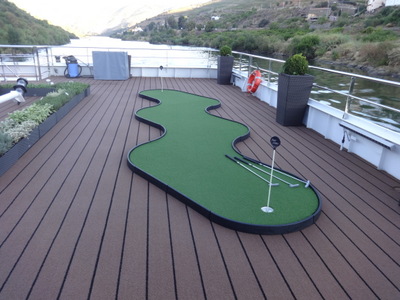
 After breakfast, I went upstairs to explore the top deck. At the left here is the putting green, located aft; three putters and two balls are provided. It's not real grass, of course, but still a reasonable putting surface.
After breakfast, I went upstairs to explore the top deck. At the left here is the putting green, located aft; three putters and two balls are provided. It's not real grass, of course, but still a reasonable putting surface.Wednesday, 26 August 2015: Pinh&atild;o to Vega Terron (in Spain), Castelo Rodrigo
Written 16 December 2015
The ship cast off very early this morning, even before the dining room opened for breakfast. Two locks today, and in the first one, we entered, rose about two-thirds of the way, and then settled back down. It seems a couple of big logs had fouled the back gate, and the water had to be let back out before they could be cleared. Once they were out of the way, we rose normally to the top, but the captain was a little worried we'd miss our appointment at the next lock. Seems you have to sign up in advance . . . As it happens, we made it, but we had to hurry a little.
Above that first lock, the water was pretty green and some patches of algal scum floated by. The Viking staff say that agricultural runoff is becoming a problem along some sections of the river. Port grapes are not fertilized, but they're not the only thing people are growing.

 After breakfast, I went upstairs to explore the top deck. At the left here is the putting green, located aft; three putters and two balls are provided. It's not real grass, of course, but still a reasonable putting surface.
After breakfast, I went upstairs to explore the top deck. At the left here is the putting green, located aft; three putters and two balls are provided. It's not real grass, of course, but still a reasonable putting surface.
At the right is the shipboard herb garden (you can see a little of it to the left of the putting green. The white object in the middle of it is the top of a metal mast with lights on top. It was folded down level with the deck to fit under the low exit of the previous lock. The herbs were real and healthy and were labeled in English and Latin, but they did not appear to be the source of the herbs used in the galley, as they showed no signs of cutting in the course of the week, even though we ate lots of herbs.

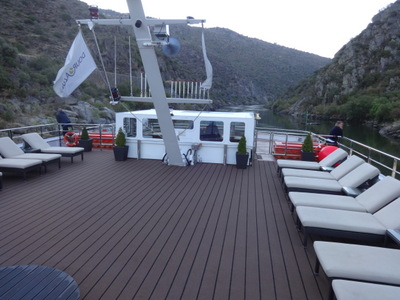 Facing the other way, toward the bow, I got this shot of the swimming pool, which was set into a platform raised above the level of the deck. I didn't go in, but some passengers did. The white structure beyond it is the bridge/wheelhouse.
Facing the other way, toward the bow, I got this shot of the swimming pool, which was set into a platform raised above the level of the deck. I didn't go in, but some passengers did. The white structure beyond it is the bridge/wheelhouse.
At the right is a closer view of the wheelhouse, with the captain inside. Note the hydraulic lifts that permit the whole structure to lowered into the deck for about half its height for passage under low bridges. The mast behind it, shown here about half lowered, can also be folded up and down as necessary.
You can see that we are about to pass through a narrow spot in the river, so a staff member is stationed at the rail on each side to warn the captain if he steers too near the rocks. I don't know whether they always do that or whether it was because we were hurrying to get to our next lock on time.
Between my position as I photographed the putting green and my position as I photographed the pool was a large shade structure with tables and more deck chairs under it. Its legs were also hinged so that it could be raised and lowered, but we never got to watch the process. The top deck was always closed during that operation, for passenger safety.
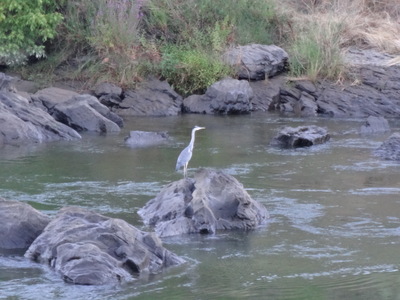
 At the left here is what was supposed to be a photo of an ash-colored heron, but it also serves to show some of the rocks the captain was so carefully avoiding.
At the left here is what was supposed to be a photo of an ash-colored heron, but it also serves to show some of the rocks the captain was so carefully avoiding.
At the right is another railroad bridge over a small tributary. The railroad paralleled the river all the way to the Spanish border.
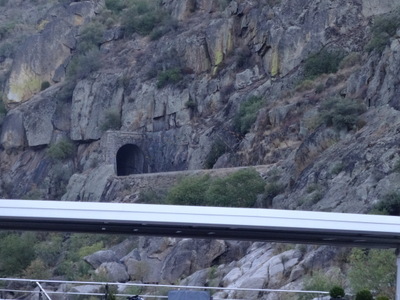
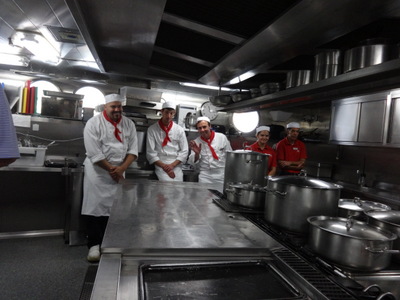 At the left here is the mouth of a railroad tunnel, showing that keeping those tracks on track was not always easy.
At the left here is the mouth of a railroad tunnel, showing that keeping those tracks on track was not always easy.
We had signed up for the 10:45 a.m. galley tour (when the possibility was announced, and we were told space was limited, Kathy and I were out of there like a shot and skidded to a stop at reception, where we were the first to arrive to sign up), so at the appointed time we and the rest of our small group of passengers were led down the stairs (concealed in the wall behind the omelet station) to the kitchens. No elevator or dumbwaiter serves the kitches, so the waiters carry all the dishes up and down those stairs for every meal. At the left here is the "brigade." From left to right: André, omelet and pasta station, support on the hot station, some desserts; Ricardo, cold station manager (salad, night cold dishes, ice cream, appetizers, appetizers); Paolo: cold station; Jessica: prep cook; Charles: dishwasher. The executive chef, Carlos, is missing from this shot. He works the hot station.
All the burners are electric; no gas is allowed (by law). They can reach 400
Charles commands two dishwashing machines, one for porcelain and another for pots and pans. (Jessica the prep cook backs him up during the rush.) A walk-in cooler accommodates frozen and fresh products. They are proud of using a lot more fresh than frozen. They keep pastry and bread dough frozen, but they bake it fresh for every meal, about 20 minutes before the service.
The kitchen starts work at 5:30 a.m., stop for a break at 2:30 or 3:00 p.m., restarts at 5:30 p.m., and finishes at 10:30 or 11:00 p.m.—all 7 days a week, all season. (We were week 23 of the season.)
The kitchen is cleaned 3 or 4 times a day. The government inspects it weekly; Viking officials inspect it every couple of months.
At the beginning of the season, they prepare 90 portions of each dish (for ca. 106 passengers!); as the season progresses and tastes become known, adjustments are made. The staff eats some of the leftovers.
On Tuesday (the previous night) 82 portions of lamb were served. The lamb was cooked 3–4 hours at low temperature; soups cook 3 to 4 hours. No butter or cream is used in the soups; they are thickened wth potato (sorry, Ev, most contain onions and garlic; I asked). Last night's gazpacho contained tomatoes, cucumber, watermelon, carrot, celery, and garlic. They serve the ame menu every week but update it every two months because of seasonal and local products. All their olives, olive oil, and quinces from one supplier, on the river route. The chef makes quince marmelade as well as other jams. The vanilla ice cream is made on board; the others made elsewhere.At 11:30 a.m., I attended another presentation on Portuguese history and culture and acquired the following information:
Then this time line:
Written 17 December 2015
Whew! All that, and it's only lunch time!
Written 21 December 2015
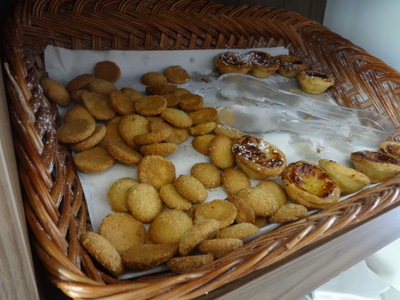
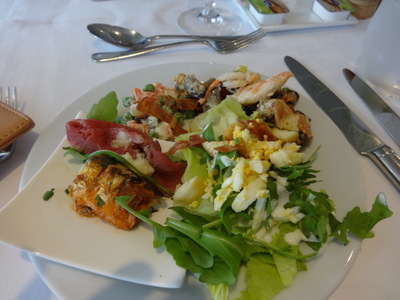 At the right here is the morning's pastry tray at the coffee station. As you can see, some people chose cookies, but the miniature pasteis de nata have suffered the greater depredations.
At the right here is the morning's pastry tray at the coffee station. As you can see, some people chose cookies, but the miniature pasteis de nata have suffered the greater depredations.
The nominal appetizer choices for lunch were sardines marinated with tomatoes and roast beef with horseradish sauce. As you can see on my plate, though, many other choices were available on the buffet. The roast beef and sardines are on a little square plate at 7 o'clock, but clockwise from behind them are some "russian salad" (mixed cooked vegetables in a creamy dressing, marinated seafood salad, and a pile of things from the salad bar.
The main-course choices were pumpkin soup with almonds, beef stroganoff with basmati rice, pasta with tomato sauce and bell peppers, and a Monte Cristo sandwich. I had the stroganoff, which was delicious but a little odd over rice rather than noodles. Kathy said the Monte Cristo was great.

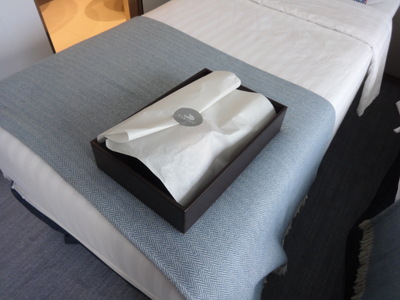 David and I both choose the apple tart with ice cream for dessert (the other choice was coffee ice cream).
David and I both choose the apple tart with ice cream for dessert (the other choice was coffee ice cream).
Back in our stateroom, we found the small batch of laundry David had bagged up that morning (or maybe the night before?), all clean and neatly folded into this wooden box and covered with Viking-sealed tissue paper. His socks have never had such royal treatment.
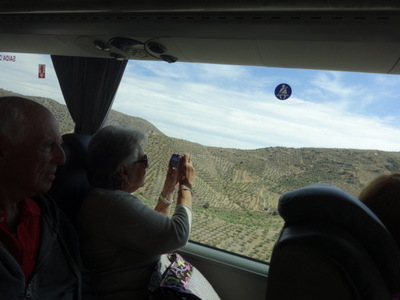
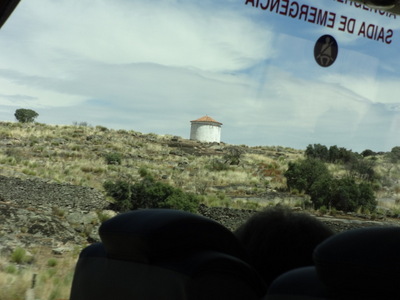 Then it was off to visit the Medieval hilltop village of Castelo Rodrigo (pronounced Cosh-TELL-oo Rod-REE-goo), a UNESCO World Heritage site. The photo at the left, taken through the bus window past a fellow passenger, shows the sort of countryside we drove through, planned with olive and almond trees.
Then it was off to visit the Medieval hilltop village of Castelo Rodrigo (pronounced Cosh-TELL-oo Rod-REE-goo), a UNESCO World Heritage site. The photo at the left, taken through the bus window past a fellow passenger, shows the sort of countryside we drove through, planned with olive and almond trees.
On many of the hilltops were these round white masonry pigeon houses with conical roofs. Peasants kept pigeons for food—the classic dish is "pigeon with rice"—and harvested the droppings (from the bottoms of the pigeon houses) to use as fertilizer. The pigeon houses were used for surveillance and security during the peninsular wars (when Napoleon invaded), and then as places to hide smuggled contraband (e.g., coca cola) during Salazar's dictatorship.
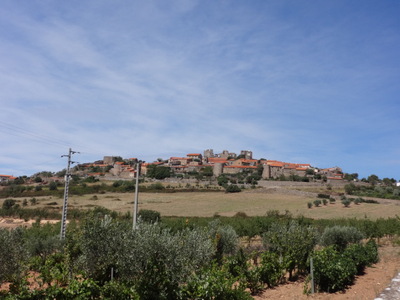
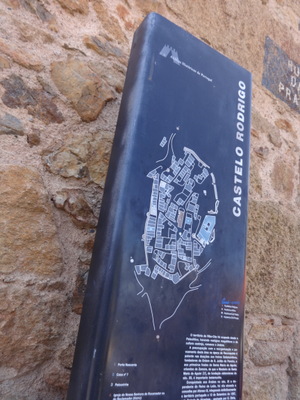 Here's our first view of the village (population 66), as we approach from the town below it, called Figuiero de Castelo Rodrigo, which served as the village's agricultural outpost and which now houses most of the area's population.
Here's our first view of the village (population 66), as we approach from the town below it, called Figuiero de Castelo Rodrigo, which served as the village's agricultural outpost and which now houses most of the area's population.
At the right is a map of the walled section of the village, posted near the pedestrian entrance (no motor vehicles in the village itself). Just inside the pedestrian gate was a tea-house-cum-gift shop featuring run by a Frenchman, Monsieur André, who married a local girl. The shop features many local products, most involving almonds, which are the major local crop.
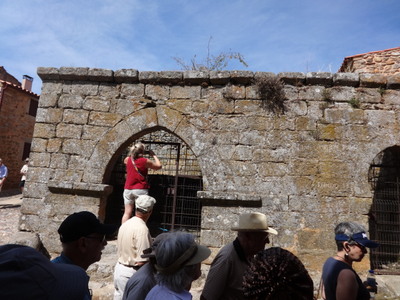
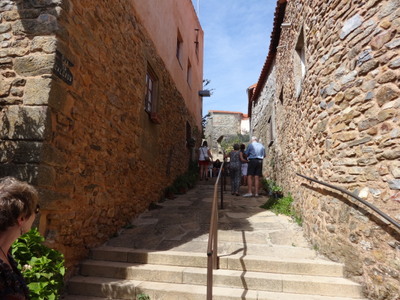 I didn't do a very thorough job of photographing the village. At the left here is a view of part of the entrance to the local cistern. It had three doors; the one on the left here is the Christian door (a plain gothic arch), on the right the moorish arch, for use by muslims. Out of sight to the right of that is the Jewish door, leading to (besides the basic water source) the village's mikvah. It's all the same water source, dipped as I gathered from the same cistern, but the village's three amicable religious groups liked entering by their own dedicated doors.
I didn't do a very thorough job of photographing the village. At the left here is a view of part of the entrance to the local cistern. It had three doors; the one on the left here is the Christian door (a plain gothic arch), on the right the moorish arch, for use by muslims. Out of sight to the right of that is the Jewish door, leading to (besides the basic water source) the village's mikvah. It's all the same water source, dipped as I gathered from the same cistern, but the village's three amicable religious groups liked entering by their own dedicated doors.
The photo at the right shows a typical "street" in the village—too steep for horses or wheeled vehicles.
Jews expelled from Spain by the inquisition took refuge in Portugal, and a group settled here, in a little neighborhood just outside the wall. To prove they had converted to Christianity, they secretly made chicken sausages, which they hung ostentatiously to dry outside their doors and would willingly eat when the inspectors came around. If they passed inspection, the inspector would engrave a cross on the doorpost, and they were okay. on the Rua Sinagoga, we were shown many houses with those crosses roughly graven into the stone doorposts.
Strangely, the village's tiny church is named for Our Lady of Rocadamour (yes, the one in France). The line was too long to get in for the guided tour, and when we came back later, the place was locked up, so we didn't get to see the inside.
At the highest point of the village is the ruin of the castle that housed the local ruler during the Spanish interruption; it's been burned and left as a ruin as a reminder. All around the village, you can see pieces of it (stones with intricate decorative carving) built into the walls of otherwise plain houses, along with other pieces of stone worth reusing, like chunks of outworn millstones.
Things learned during the rides to and from Castelo Rodrigo:

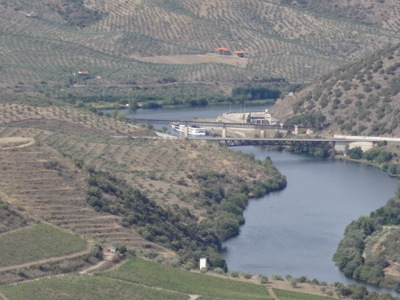 On the way back to join the Hemming, we stopped, as promised, at a site where we could see griphon vultures, and possibly even Egyptian vultures. To my surprise, it was an overlook that permitted us to look down on the vultures as they soared and perched. Believe it or not, the photo on the left shows a griphon vulture perched on a rock outcrop. The outcrop is whitened with droppings (it must be a favorite perch), just to the left of and slight below it, you can see a patch of prickly pear. The vulture is perched on the edge of the rock, its white head and most of its body visible against the soft green of the bushes behind it. That's the best I could do, even with telephoto. We got to stand there quite a while, though, watching the vultures soaring back and forth across the valley below us (as I say somewhere in every blog, always travel with binoculars). Experts in the group said they thought they spotted an Egyptian among the griphons, but they couldn't be sure.
On the way back to join the Hemming, we stopped, as promised, at a site where we could see griphon vultures, and possibly even Egyptian vultures. To my surprise, it was an overlook that permitted us to look down on the vultures as they soared and perched. Believe it or not, the photo on the left shows a griphon vulture perched on a rock outcrop. The outcrop is whitened with droppings (it must be a favorite perch), just to the left of and slight below it, you can see a patch of prickly pear. The vulture is perched on the edge of the rock, its white head and most of its body visible against the soft green of the bushes behind it. That's the best I could do, even with telephoto. We got to stand there quite a while, though, watching the vultures soaring back and forth across the valley below us (as I say somewhere in every blog, always travel with binoculars). Experts in the group said they thought they spotted an Egyptian among the griphons, but they couldn't be sure.
The other photo in this pair shows the Hemming (below the farther of the two bridges) waiting for us at Vega de Terron, our only Spanish port of call. At this point, the river forms the national boundary, so we're on the Portuguese side, looking across at the Spanish side. According to the Viking guides, Vega de Terron has only two inhabitants—the guy who runs the little store you can see above the ship and his mother.
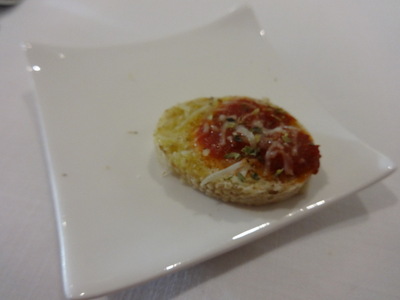
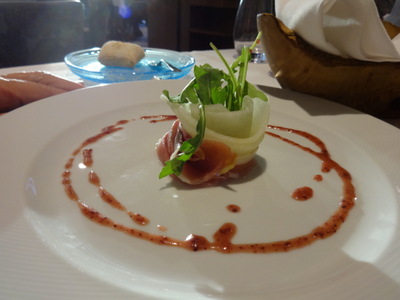 Here's the amuse-bouche from dinner—a little tart of something. Unfortunately, they didn't print it on the menu, and I forgot to write it down.
Here's the amuse-bouche from dinner—a little tart of something. Unfortunately, they didn't print it on the menu, and I forgot to write it down.
At the right is one of the first courses, Lamego ham with melon (the melon sliced thin and rolled into a rose). The pink drizzle around it is grape vinaigrette.
Two Other appetizer choices were creamy leek soup and chef's salad.

 I had the fourth choice, roasted fresh mushrooms with asparagus and little toasts.
I had the fourth choice, roasted fresh mushrooms with asparagus and little toasts.
My main course was panfried John Dory (a fish, Zeus faber), shown here balanced across the top of two slightly crushed boiled new potatoes and decorated with sautéed strips of turnip greens.
The vegetarian main-course option was pasta with oil, garlic, and vegetables.

 David chose the third option, tender pork medallions with celery-root puré, with a brown gravy and a shower of bits of braised celery stalk.
David chose the third option, tender pork medallions with celery-root puré, with a brown gravy and a shower of bits of braised celery stalk.
For dessert, Kathy chose the "semifredo of lemon," which turned out to be this multilayered chiffon pie sort of thing. She declared it excellent.
Other choices were a plate of sliced kiwi fruit and vanilla ice cream. Any of the above could be topped with chocolate sauce, butterscotch, or mixed berries.

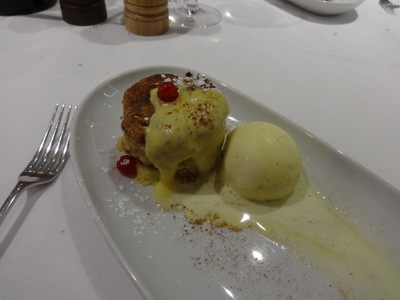
I had the mandarin orange sorbet, unadorned. Very good.
David had the bread pudding with custard sauce and house-made vanilla ice cream, which was also excellent.
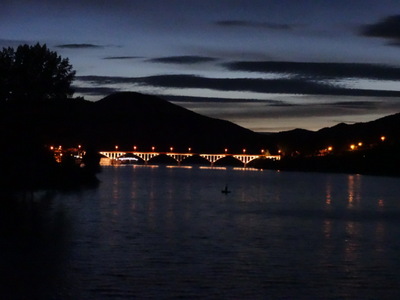 Finally, here's a night view of the Ponte Almirante Sarmento Rodrigues, named for a Portuguese naval officer, which spans the Douro at Barca d'Alva, the Portuguese town across from Vega de Terron. It was built in 1955 by Edgar Cordoso (1913–2000), a famous bridge-builder from Porto. In the course of the week, we were shown several other works of his.
Finally, here's a night view of the Ponte Almirante Sarmento Rodrigues, named for a Portuguese naval officer, which spans the Douro at Barca d'Alva, the Portuguese town across from Vega de Terron. It was built in 1955 by Edgar Cordoso (1913–2000), a famous bridge-builder from Porto. In the course of the week, we were shown several other works of his.